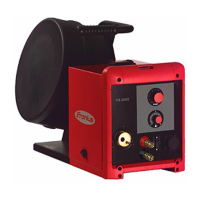Protecting your-
self and others
Anyone working with the device exposes themselves to numerous risks, e.g.
-
flying sparks and hot pieces of metal
-
Arc radiation, which can damage eyes and skin
-
Hazardous electromagnetic fields, which can endanger the lives of those us-
ing cardiac pacemakers
-
Risk of electrocution from mains current and welding current
-
Greater noise pollution
-
Harmful welding fumes and gases
Suitable protective clothing must be worn when working with the device. The
protective clothing must have the following properties:
-
Flame-resistant
-
Insulating and dry
-
Covers the whole body, is undamaged and in good condition
-
Safety helmet
-
Trousers with no turn-ups
Protective clothing refers to a variety of different items. Operators should:
-
Protect eyes and face from UV rays, heat and sparks using a protective visor
and regulation filter
-
Wear regulation protective goggles with side protection behind the protect-
ive visor
-
Wear stout footwear that provides insulation even in wet conditions
-
Protect the hands with suitable gloves (electrically insulated and providing
protection against heat)
-
Wear ear protection to reduce the harmful effects of noise and to prevent in-
jury
Keep all persons, especially children, out of the working area while any devices
are in operation or welding is in progress. If, however, there are people in the vi-
cinity:
-
Make them aware of all the dangers (risk of dazzling by the arc, injury from
flying sparks, harmful welding fumes, noise, possible risks from mains cur-
rent and welding current, etc.)
-
Provide suitable protective equipment
-
Alternatively, erect suitable safety screens/curtains.
Danger from tox-
ic gases and va-
pours
The fumes produced during welding contain harmful gases and vapours.
Welding fumes contain substances that can cause cancer, as stated in Mono-
graph 118 of the International Agency for Research on Cancer.
Use at-source extraction and a room extraction system.
If necessary, use a welding torch with an integrated extraction device.
Keep your face away from welding fumes and gases.
Fumes and hazardous gases
-
must not be breathed in
-
must be extracted from the working area using appropriate methods.
Ensure an adequate supply of fresh air with a ventilation rate of at least 20 m³/
hour.
Otherwise, a protective mask with an air supply must be worn.
Close the shielding gas cylinder valve or main gas supply if no welding is taking
place.
9
EN

